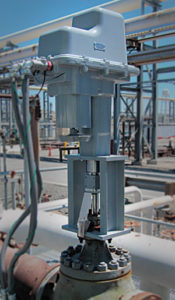 Increasing Business Pressures Necessitate Control Improvements
Increasing Business Pressures Necessitate Control Improvements
Energy costs represent a major portion of a refinery or petrochemical plant’s operating expense. As such, poor valve and damper control is increasingly impacting plant profits. Additionally, environmental regulations continue to mandate lower emission levels. Poor control caused by imprecise or duty-cycle limited actuators can no longer be tolerated. Beck actuators for oil refineries, gas pipelines and natural gas valves have been used for over 70 years in heavy manufacturing to improve combustion control, increase reliability and reduce cost. Beck’s unique motor and gear design is perfectly suited to the demanding furnace, heater, chemical ESD valves and boiler applications in today’s plants.
Valve and Damper Actuation is Key to Combustion Control and Efficiency
In spite of the critical role of combustion control valves and dampers, their performance is often ignored. In many cases, valve and damper actuator problems are addressed only after a serious failure occurs.
Valve and damper actuators are a leading source of combustion control problems. Pneumatic actuators are inherently susceptible to stick/slip response, excessive dead time, inconsistent performance with changing conditions, and performance degradation over time. As a result, pneumatic actuation simply cannot provide the level of control performance provided by Beck actuators. Similarly, conventional electric actuators are poorly suited for active combustion control since most are limited by motor duty-cycles, provide less accurate positioning capabilities, and are less reliable– especially in the harsh operating conditions for which Beck actuators are designed.
 This example shows the dramatic improvements caused by replacing pneumatic actuators with Beck actuators for gas valve pressure control. The valves control the flow of by-product refinery gas that is blended with natural gas and burned in utility-operated boilers supplying steam and power to the refinery. This refinery gas historically has significant contamination, creating stick / slip in valves positioned by pneumatic actuators.
This example shows the dramatic improvements caused by replacing pneumatic actuators with Beck actuators for gas valve pressure control. The valves control the flow of by-product refinery gas that is blended with natural gas and burned in utility-operated boilers supplying steam and power to the refinery. This refinery gas historically has significant contamination, creating stick / slip in valves positioned by pneumatic actuators.
This graph shows historical pressure variability data; including average pressure as well as high and low pressure extremes over time. Note that pneumatic actuators controlled gas header pressure to +/- 2.0 lb and resulted in several pressure control alarms. Replacement with Beck actuators resulted in an immediate reduction in gas header pressure variability down to +/- 0.5 lb, and all pressure control excursions were eliminated.
Field Proven Results
This example shows the dramatic improvements caused by replacing pneumatic actuators with Beck actuators for gas valve pressure control. The valves control the flow of by-product refinery gas that is blended with natural gas and burned in utility-operated boilers supplying steam and power to the refinery. This refinery gas historically has significant contamination, creating stick / slip in valves positioned by pneumatic actuators.
This graph shows historical pressure variability data; including average pressure as well as high and low pressure extremes over time. Note that pneumatic actuators controlled gas header pressure to +/- 2.0 lb and resulted in several pressure control alarms. Replacement with Beck actuators resulted in an immediate reduction in gas header pressure variability down to +/- 0.5 lb, and all pressure control excursions were eliminated.
Many Boilers & Heaters are Benefiting from Beck Drives … and the Number is Growing
Investments in advanced control instrumentation and logic are necessary, but are only as effective as the precision, repeatability and responsiveness of the valves and dampers. Plants that understand the importance of the final control element replace poorly performing pneumatic and traditional electric actuators with Beck actuators.
Beck actuators have been used to improve valve and damper performance in over 1,000 electric utility boilers. The same type of improvements are now increasingly being realized in refineries on process heaters and boilers.
 All Control Applications Benefit from Beck Drives
All Control Applications Benefit from Beck Drives
Regardless of whether the equipment is a gasfired heater, a waste gas boiler, or a blending valve in the tank farm, Beck provides distinct advantages over other actuator alternatives. Combustion control–especially where process flows might vary, or where external disturbances exist–can be optimized based on the actuator’s ability to track a demand signal closely without modulation restrictions or performance inconsistencies. Improving final control element positioning, while eliminating dead time and overshoot, always results in better process control. Loops not only perform better, but are also easier to tune, stay tuned longer, and are more tolerant of varying conditions.
In addition to control advantages, Beck actuators are more rugged and reliable than either pneumatic or other electric actuators. The Beck cast aluminum housing is rated Type 4X and meets hazardous location requirements typical for refinery and other petrochemical environments. Furthermore, Beck’s low current draw motor saves energy by replacing inefficient compressed instrument air.
Download a copy of our Refinery and Petrochemical brochure
Motor
The Beck Motor: 100% Availability
Beck’s unique motor design makes the precise, reliable performance of the actuators possible. This no burnout motor ensures that the actuator is available 100% of the time. There are no duty cycle limitations typical of most electric actuators, so the actuator performs as the loop requires rather than the loop performing as the actuator permits.
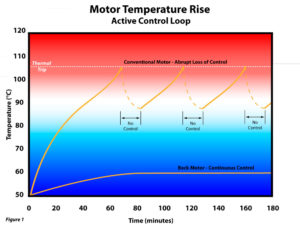
The Beck Motor:
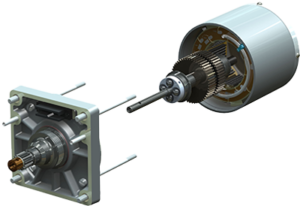
- Reaches full speed and torque in milliseconds and stops in milliseconds, eliminating dead time.
- Provides extremely accurate and repeatable positioning for modulating applications.
- Will not coast or overshoot the desired position.
- Draws low current (0.16 A to 3.0 A). The low power consumption permits easy use with uninterruptible power supplies.
- Uses double-lipped, grease-sealed bearings for maintenance-free operation.
- And . . .Never overheats or burns-out; even under demanding modulating control or stalled conditions.
Electronics
Digital Electronics: Repeatable Control, Simple Operation, and Diagnostic Capabilities
Our field-proven electronics provide excellent position control in response to modulating control signals. This maximizes control loop performance by ensuring that the actuator responds exactly as the control loop requires.
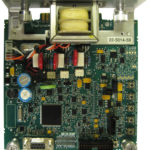 The DCM-3 is equipped with a local interface panel for pushbutton calibration functions without the need for external devices or software. LED diagnostic lights display a number of status conditions.
The DCM-3 is equipped with a local interface panel for pushbutton calibration functions without the need for external devices or software. LED diagnostic lights display a number of status conditions.
The DCM-3 is also equipped with a HART® communications interface to provide bidirectional digital communications over the existing analog demand wiring—providing access to the added functions and information without interfering with control or requiring new wiring. Communications can be established either remotely or locally using any standard HART®-based communication tool and is compatible with common asset management systems. Optionally, the DCM can be equipped with Foundation Fieldbus® or Profibus PA® communication capability.
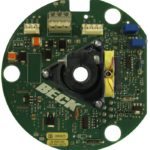 Beck’s Contactless Position Sensor (CPS) also resides within the actuator, and provides reliable internal position feedback to the DCM for position control. The DCM also uses the sensor signal to source a 4–20 mA external position signal for remote monitoring of actuator position. Unlike typical position sensors, the CPS does not wear due to its contactless design.
Beck’s Contactless Position Sensor (CPS) also resides within the actuator, and provides reliable internal position feedback to the DCM for position control. The DCM also uses the sensor signal to source a 4–20 mA external position signal for remote monitoring of actuator position. Unlike typical position sensors, the CPS does not wear due to its contactless design.
Limit Switches
Over-travel Limit Switches
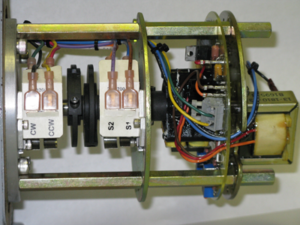 Beck actuators include heavy-duty, single-pole, double-throw (SPDT) switch mechanisms for electrical over-travel protection. Switch cams will not slip because each is mounted to the shaft by an integral, tangential clamping means—with no set screws to mar the shaft.
Beck actuators include heavy-duty, single-pole, double-throw (SPDT) switch mechanisms for electrical over-travel protection. Switch cams will not slip because each is mounted to the shaft by an integral, tangential clamping means—with no set screws to mar the shaft.
Every actuator is equipped with two over-travel limit switches. Optionally, actuators can be equipped with up to four auxiliary switches that can be set to operate at any desired point of actuator travel, thus providing discrete inputs for control or indication.
Common throughout most Beck actuator models, the SPDT switches provide the following:
- A maximum rating of 6 A at 120 V ac (three times the maximum motor current for most models) to ensure long life.
- Auxiliary switches are field-adjustable with infinite positioning throughout the actuator’s travel range.
- May initiate secondary functions or provide remote indication of actuator position.
Drive Train
Drive Train: Power and Durability
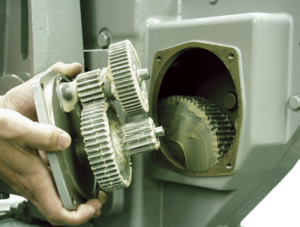 Beck’s durable gear train maintains accurate, consistent positioning even under the demanding conditions of an active control loop.
Beck’s durable gear train maintains accurate, consistent positioning even under the demanding conditions of an active control loop.
-
- Gear trains employ a unique, all spur gear construction using only heat-treated alloy steels and ductile iron.
-
- Efficient, wide-faced spur gears ensure long life and eliminate wear-induced backlash and positioning inaccuracies common in worm gear and “Scotch-yoke” designs.
-
- Integral self-locking mechanism ensures that actuators hold a minimum of 200% of rated torque with the motor de-energized.
-
- Durable design provides up to 4 days of protection against intermittent or extended accidental stalls.
- Stall protection is provided by the DCM. If the motor tries to run in one direction for more than 300 seconds, the DCM-2 will shut off power to the motor and a status indication LED will activate indicating a stall.
Local Manual Control
Local Manual Control
All Beck actuators are built with local positioning capabilities. An electric Handswitch allows electrical local operation of the actuator, while a convenient Handwheel, or Handcrank on some high torque actuators, allows manual positioning of the actuator output shaft without electric power.
Handswitch
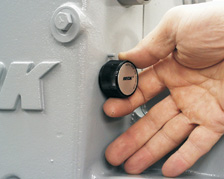
The electric Handswitch allows the actuator to be positioned locally and is very useful for the initial setup of the actuator and linkage. It also serves as a diagnostic tool or a backup control device in the event the loop controller or demand signal malfunctions.
Handwheel
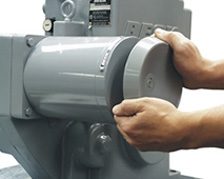
Even in the absence of power, and with full load applied, the actuator output shaft can be manually positioned using the easy-to-turn, spoke-free Handwheel. No clutch mechanism is required and mechanical stops protect against manual overtravel.
Housing
Housing: Superior Protection and Convenient Access to Components
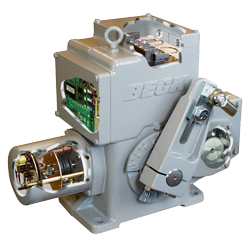 Beck actuators feature a cast aluminum body with individual compartments to protect components from moisture and dirt, and allow easy access for installation and calibration.
Beck actuators feature a cast aluminum body with individual compartments to protect components from moisture and dirt, and allow easy access for installation and calibration.
- Precision-machined aluminum alloy castings with corrosion-resistant polyurethane paint provide a rugged, dust-tight, weatherproof Type 4X enclosure.
- Individual compartments protect all major components: Motor, DCM-2, CPS, gear train and installation wiring terminal board.
- Gasketed covers provide extra protection for abusive indoor environments and harsh outdoor climates.
- Each compartment can be accessed without exposing other components to the environment.
- Output and Handwheel shafts are sealed with weatherproof, double-lip cartridge seals.
Linkage
Linkage: Beck Linkage Kits and Link-Assist™ Program Ensure the Best Connection
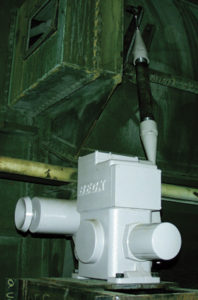 The unique design of the crank arm allows infinite position adjustment to simplify installation. Engineered linkage kits are available to complete the connection from the crank arm to the damper. Once the connection is made, the linkage length may be adjusted, simplifying the final mechanical calibration. Also, Beck rod ends incorporate a bearing to compensate for some lateral misalignment.
The unique design of the crank arm allows infinite position adjustment to simplify installation. Engineered linkage kits are available to complete the connection from the crank arm to the damper. Once the connection is made, the linkage length may be adjusted, simplifying the final mechanical calibration. Also, Beck rod ends incorporate a bearing to compensate for some lateral misalignment.
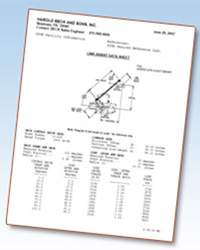 Beck’s Link-Assist™ program provides a printout showing the optimum actuator and linkage configuration for the application. The linkage arrangement can be characterized to match the torque profile of the application. Request this free service to save time, simplify installation and ensure the best performance at the lowest possible cost.
Beck’s Link-Assist™ program provides a printout showing the optimum actuator and linkage configuration for the application. The linkage arrangement can be characterized to match the torque profile of the application. Request this free service to save time, simplify installation and ensure the best performance at the lowest possible cost.

